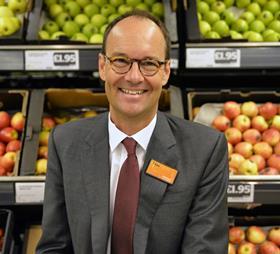
What is the importance of the fresh produce category to Sainsbury’s future strategy?
Mike Coupe: Fresh produce is one of our core businesses. It’s one of the key determinants of where customers choose to shop, so for us as a business it’s absolutely essential, and it’s one of the areas we want to continue to invest in and develop.
How do you plan to get closer to fresh produce suppliers?
MC: We have many grower groups across our agriculture and horticulture supply chain. Our most developed group is in dairy, but we try and set up grower groups in many other categories. The underlying principle is the same – it’s about bringing together groups of people to share data and best practice. You can’t tell a farmer what to do, but if he knows his neighbour is doing it then that provides an incentive.
You’ve committed to a further £500 million in price investment. Can you confirm whether these cuts will be in the fresh produce category?
MC: The price competition on produce has undoubtedly stepped up over the last couple of years, and it’s become a key battleground, but you could argue that’s always been the case. We are comfortable with where we are today in our price position – that doesn’t necessarily mean that other people won’t invest in price, and we will respond to that because we always aim to be competitive.
We will make targeted price investments without being specific about which category, because we’d like to keep our powder dry. You don’t want to be telling your opposition that you’re making a price investment in a particular category. It’s fair to say there’s been a lot of price competition on produce in the retail sector, and we’ve matched our competition toe to toe and we will continue to do so.
Will you be sourcing more British produce in the face of higher import costs?
MC: Generally we source virtually everything we can from the UK so in lots of ways it would be difficult to step it up any more, because we’re pretty much as British as we can be. The point we’re making at the conference today is the source of competitive advantage is changing – being British is no longer good enough. We have to think about how we can make the Sainsbury’s offer more distinctive, and we’re working with our suppliers to do this.
Will this involve going direct to growers more, or consolidating the supply base to larger suppliers but fewer of them?
MC: We don’t really look to discriminate by size, but what we are increasingly doing is reaching through our supply chain from an end-to-end point of view and understanding where the costs are, where the opportunities are, and therefore how best to manage the supply chains to get the best outcome. That doesn’t necessarily mean scale is important – in some cases scale is actually a disadvantage – but equally by understanding supply chains we can do a better job at finding the inefficiencies, and ultimately deliver a better product, more cost-effectively.
Do you believe the tides are beginning to turn with slower growth for the discounters and successful turnaround strategies from the big four?
MC: There’s no doubt that the discounters’ growth has slowed – this time last year we were still seeing growth rates of 15 to 20 per cent. Now the growth rates are five to 10 per cent but, perhaps more importantly, that five to 10 per cent is only where the new stores are opening, not underlying sales growth. Generally speaking, that would suggest the market is getting to a more stable position.
Now, we are only talking about a couple of months of data, so it’s dangerous to call the trend, but you could hypothesise that a lot of the action we’ve taken has worked. And it’s not just about price, it’s about making the offer more distinctive and playing to the advantages we have.
Although price has undoubtedly been a big area of investment over the last couple of years, there are other things we can do better and we will do better.



